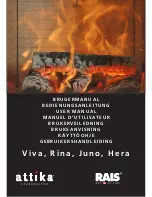
28
Prior to installing the appliance, examine the chimney for cracks, poor connections, oxidation,
loose mortar or other signs of deterioration and blockage.
Make sure the size of the chimney is appropriate for the stove
. Consult the manufacturer’s
recommended dimensions.
Use of a chimney that is too small or oversized may cause the stove to fail to function
properly, contributing to the build-up of creosote.
MASONRY CHIMNEYS
The advantages of these chimneys are:
The mass of bricks and/or floor tiles reduce the cooling of the vapours in the chimney.
The heat accumulating characteristic of bricks allows the house to be kept warm for a
longer period once the fire has gone out.
It can be built to suit individual taste.
If it is well built, it may be more resistant to fire than metal chimneys.
Masonry chimneys should be well lined around the exterior of the building to avoid the
cooling of vapours. They should be built with materials that withstand high temperatures and
corrosion.
Make sure that the chimney is clean and functions correctly, so as to prevent loss of flue and
the accumulation of creosote.
Make sure that the size of the chimney is appropriate
and is not too high.
If it is excessively high, a flue shut-off valve should be
installed.
If your masonry chimney is of a greater section than that
recommended by the manufacturer of the appliance, it is
advisable to install inside another metal chimney with the
appropriate dimensions in order to avoid operating
problems and the build-up of creosote.
In this case, it is advisable to seal one of the ends of the
masonry chimney to avoid the creation of drafts which
may cool the chimney. (See Fig.-3)
It is advisable that this sealing is performed in the upper
part, so as to take advantage of the heat that is
produced throughout the whole chimney. Similarly, it is
advisable to perform a circulation inside this chamber
between the pipes and the masonry chimney to allow a
certain relief and avoid excessive heat which produces
deterioration in the walls (cracks, etc.). It is suffice to
position a lower and upper grate (15x10 cm.) in this
chamber. The air will circulate by natural convection,
taking the hot air from the lower part to the upper part of
the building.
Fig.- 2
SEALING ONE
OF THE ENDS
















































